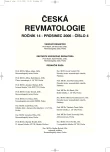-
Medical journals
- Career
Still’s disease in adults
Authors: K. Jarošová
Authors‘ workplace: Revmatologický ústav Praha
Published in: Čes. Revmatol., 14, 2006, No. 4, p. 159-163.
Category: Overview Reports
Overview
The clinical features of Still’s disease with the onset in adult age are described in this review. With respect to the clinical and laboratory manifestations, this disease resembles its juvenile counterpart. The influence of the disease on child’s organism is more severe and often leads to serious disability. It is difficult to diagnose both forms of the disease. It usually can be diagnosed when other causes of systemic manifestations including fevers, rush, hepatosplenomegaly, lymphadenopathy, and serositis are excluded. Arthritis that can occur at any time of the disease is variable. In about half of the patients, it proceeds into severe erosive polyarthritis. The treatment of Still’s disease is based on administration of nonsteroidal anti-inflammatory drugs and glucocorticoids. Methotrexate, as a disease modifying drug, is used most often. In more severe cases, biologicals or surgery may be considered.
Key words:
Still’s disease, systemic manifestations, arthritis, classification criteria, treatment
Labels
Dermatology & STDs Paediatric rheumatology Rheumatology
Article was published inCzech Rheumatology

2006 Issue 4
Most read in this issue- Diagnosis, differential diagnosis, and management of erythema nodosum
- Still’s disease in adults
- Unusual course of panniculitis with ascites
- Complications after knee joint replacement in patients with rheumatoid arthritis
Login#ADS_BOTTOM_SCRIPTS#Forgotten passwordEnter the email address that you registered with. We will send you instructions on how to set a new password.
- Career

